Life scientists employ many techniques in numerous scientific fields to elucidate the function of biological processes. Armed with data gathered from multiple studies, the incredibly complex structure of biological systems has become more intimately understood in recent years. This article will concentrate on biophysical chemistry, a multi-disciplinary scientific field.

Biophysical Chemistry. Image Credit: luchschenF/Shutterstock.com
Biophysical Chemistry
What is biophysical chemistry? At its core, the goal of this field is to provide physical explanations for the biophysical chemist for why biological systems function in the way they do. It is a branch of the wider field of biophysics. This multidisciplinary field has a long history, with the term coined in 1892 by Karl Pearson, an English biostatistician and mathematician.
Biophysical chemistry is an interdisciplinary field, combining elements of biology, chemistry, and physics. It is aimed at the collection and analysis of quantitative data for predictive physical models of biological phenomena at the molecular level. It is also used to describe techniques that study the physical properties of important biological molecules at the chemical level.
Techniques Employed
Biophysical chemists employ a variety of techniques for different uses within the field. These cover multiple scientific disciplines.
Nuclear magnetic resonance (NMR) and other spectroscopic tools are used in combination with diffraction methods to define the atomic structure of molecules. Electronic paramagnetic resonance (EPR) spectroscopy, as well as optical and vibrational spectroscopies, are used to probe the electronic structure of active sites.
Time-resolved laser spectroscopy is used to follow the course of catalyzed processes along with traditional kinetic and thermodynamic methods. Macromolecular structures of important biological molecules are altered by organic synthesis and molecular biology techniques to test functional models. Computer models which reflect the best understanding of the electronic structure of biological molecules are used to test processes and structures.
There are numerous other techniques used as well. Information theory, network and system theory, non-equilibrium statistical thermodynamics, and even quantum mechanics are employed by biophysical chemists. Integration of these diverse fields is key to understanding biological systems from a biophysical chemistry standpoint.
Examples of Systems Studied Using Biophysical Chemistry Techniques
Biophysical chemists study numerous structures and processes within an organism. The field has contributed to several important advances in our understanding of biological systems. These include:
- Protein-ligand interactions
- The structure and dynamics of enzymes
- Nucleic acid structure
- Nucleic acid-protein complexes
- The structure and dynamics of membrane-bound proteins
- The structure and dynamics of metalloproteins (such as metallopeptidases and hemoglobin)
- Computer modeling of denaturation pathways and protein structure.
Important biological processes such as gene regulation and expression, replication, signal transduction, energy storage, photosynthesis, and vision have become better-understood thanks to multiple studies. Biophysical chemistry is used in diverse fields such as de novo protein design and drug discovery.
Water: An Example of Systemic Molecular Complexity
Biological systems are incredibly complex and dynamic, and understanding how molecules behave in a variety of processes is important. Take the example of water, a simple molecule, consisting of two hydrogen atoms and one oxygen atom, it is essential for life on earth.
Water reacts with polar and non-polar molecules and even surfaces that are not in solution in a variety of ways, some of which are poorly understood. Effective tools that can predict and model the interactions between water and heterogeneous biological systems in cells are therefore needed. Biophysical chemistry techniques can model this accurately. This illustrates how important biophysical chemistry studies are for even relatively simple but important biological processes.
Biophysical Chemistry and Nanotechnology
Nanotechnology is a recent field that has been applied to medical science. Nanomaterials are used in imaging, bioassays, sensors, and a multitude of applications and emerging technologies. The surface properties of nanoscale materials are extremely sensitive to change due to factors such as their large surface area and fast electron transfer.
Nanomaterials interact with biomolecules in diverse ways, responding to their introduction into a biological system and undergoing structural changes as a result. Biologically important molecules such as nucleic acids, proteins, as well as membranes, interconnect with nanomaterials in a sophisticated manner. Understanding the biophysical reactions of endogenous biomolecules with nanotechnology is central to designing nanomaterials that are safe for use in medical applications.
Biophysical chemistry and its associated techniques can provide valuable information on these interactions at the molecular level. The importance of its use in the field of nanotechnology cannot be understated. This is but one example of the application of biophysical chemistry to other fields of medical science.
In Conclusion
Biophysical chemistry is a cutting-edge scientific field that has found application in a diverse range of life science disciplines. The array of techniques employed by biophysical chemists is growing all the time. The field will no doubt find a use for many years to come.
References:
- Yale University Department of Chemistry (website) Biophysical Chemistry [Accessed online 11th July 2021] https://chem.yale.edu/gallery/biophysical-chemistry
- Trnková, L & Farka, Z (2017) Advanced nano- and biomaterials in biophysical chemistry Monatsh Chem. 148 1899-1900 [Accessed online 11th July 2021] https://link.springer.com/article/10.1007/s00706-017-2063-0
- Sukenik. S, Harries, D & Friedler, A (2019) Biophysical Chemistry Reference Module in Chemistry, Molecular Sciences and Chemical Engineering [Accessed online 11th July 2021 https://www.sciencedirect.com/science/article/pii/B9780124095472053853
Last Updated: Aug 23, 2021

Written by
Reginald Davey
Reg Davey is a freelance copywriter and editor based in Nottingham in the United Kingdom. Writing for News Medical represents the coming together of various interests and fields he has been interested and involved in over the years, including Microbiology, Biomedical Sciences, and Environmental Science.
Source: Read Full Article